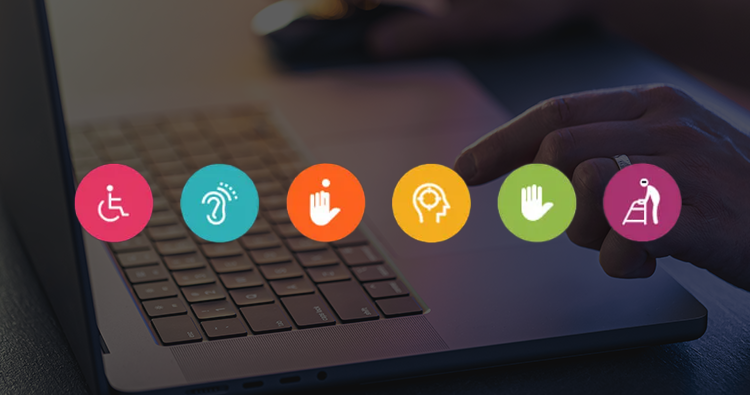Introduction

In the rapidly evolving landscape of healthcare technology, user experience (UX) design has emerged as a crucial factor in the success and effectiveness of healthcare applications. In the ever-evolving landscape of healthcare, the intersection of technology and user experience (UX) design has become pivotal in delivering accessible and compliant healthcare applications. In this blog post, we will delve into the key reasons why UX design is of paramount importance in healthcare application development and the critical role of healthcare regulations and accessibility standards in shaping UX design for healthcare applications.
The Vital Role of UX Design in Healthcare Application Development

Enhancing Patient Engagement:
A well-crafted UX design in healthcare applications fosters increased patient engagement. By creating interfaces that are easy to navigate and understand, users, including patients and healthcare professionals, are more likely to actively participate in using the application.
Improving Accessibility and Inclusivity:
Healthcare applications should cater to users with diverse needs and abilities. A thoughtful UX design takes into account accessibility standards, ensuring that the application is usable by individuals with various disabilities. This inclusivity not only aligns with ethical considerations but also expands the reach and impact of healthcare services to a broader audience.
Streamlining Workflows for Healthcare Professionals:
Healthcare professionals deal with complex and time-sensitive tasks daily. An intuitive UX design optimizes workflows, making it easier for doctors, nurses, and other healthcare providers to access critical information, input data, and communicate effectively. This not only saves time but also reduces the risk of errors in healthcare settings.
Ensuring Data Security and Privacy:
Healthcare applications handle sensitive and private information, making security a top priority. A well-designed UX considers privacy concerns and implements robust security measures without compromising the user experience.
Facilitating Seamless Information Retrieval:
In healthcare, quick access to accurate information is paramount. A user-centric design ensures that users can easily retrieve relevant data, whether it’s personal health records, medication details, or test results. This facilitates informed decision-making and empowers users to actively manage their health.
Compliance with Regulatory Standards:
Healthcare applications must comply with various regulatory standards and guidelines. UX designers need to be well-versed in these requirements to create interfaces that meet legal and industry standards. Ensuring compliance not only avoids legal issues but also contributes to building a trustworthy reputation for the healthcare application.
Understanding Healthcare Regulations

HIPAA Compliance:
The Health Insurance Portability and Accountability Act (HIPAA) sets stringent standards for protecting patient data. Healthcare application designers must prioritize data security and implement robust encryption methods to ensure compliance.
FDA Regulations:
For applications involving medical devices or software that impacts clinical decision-making, adherence to the Food and Drug Administration’s (FDA) regulations is crucial. UX designers must work closely with regulatory experts to ensure the application meets the necessary standards for approval.
Interoperability Standards:
With the push for healthcare interoperability, designers must consider standards like FHIR (Fast Healthcare Interoperability Resources) to ensure seamless data exchange between different healthcare systems. A user-friendly interface that supports interoperability can improve overall patient care coordination.
Accessibility in Healthcare Application UX Design

User-Centric Design:
UX designers need to adopt a user-centric approach, keeping in mind the diverse needs of patients, including those with disabilities. Prioritizing user research and testing with individuals of varying abilities ensures a more inclusive and accessible healthcare application.
Compliance with WCAG:
Adhering to the Web Content Accessibility Guidelines (WCAG) is essential. Designers should focus on providing alternative text for images, ensuring keyboard navigation, and incorporating other accessibility features to guarantee usability for individuals with visual, auditory, motor, or cognitive impairments.
Readable Typography and Color Contrast:
Healthcare applications should feature readable typography and sufficient color contrast to accommodate users with visual impairments. Designers should choose fonts and colors carefully, considering both aesthetic appeal and accessibility.
Voice Commands and Gesture Recognition:
Integrating voice commands and gesture recognition can enhance accessibility, particularly for users with mobility challenges. This allows individuals to navigate and interact with the application using spoken commands or simple gestures.
Inclusive Language and Culturally Sensitive Design:
Ensuring that the application uses inclusive language and culturally sensitive design is vital. This helps create a positive user experience for individuals from diverse backgrounds and contributes to equitable healthcare access.
Conclusion
In conclusion, Effective UX design is crucial for healthcare applications, impacting patient engagement, accessibility, workflow efficiency, data security, and regulatory compliance. Prioritizing user experience is essential for the success of healthcare apps, contributing to overall service improvement and outcomes. Balancing regulatory compliance, especially with standards like HIPAA, and ensuring accessibility presents a multifaceted challenge. Collaborating with UX designers, regulatory experts, and healthcare professionals will be key in shaping the future of healthcare application design.



